As soon as you have a large population, there is a lot of development, which in turn, boosts economic growth. This is why some of the largest cities in the U.S. are also the most populated. According to the U.S. Census Bureau, the population of the United States in 2023 consists of 334,233,854 people. Below is a detailed article about the largest cities in the United States by population size, total area, and economic impact.

| Ranking | City | Population Size |
|---|---|---|
| 1. | New York, New York | 7,888,121 |
| 2. | Los Angeles, California | 3,769,485 |
| 3. | Chicago, Illinois | 2,608,425 |
| 4. | Houston, Texas | 2,264,876 |
| 5. | Phoenix, Arizona | 1,651,344 |
1. New York, New York
As of 2023, the largest city in the United States, New York, has a population of 7,888,121. While the Big Apple has the most people in the U.S., its population has declined since there were 8,772,978 residents in 2020. Because New York spans over 468 miles, it has a population density of 26,261 individuals per square mile.
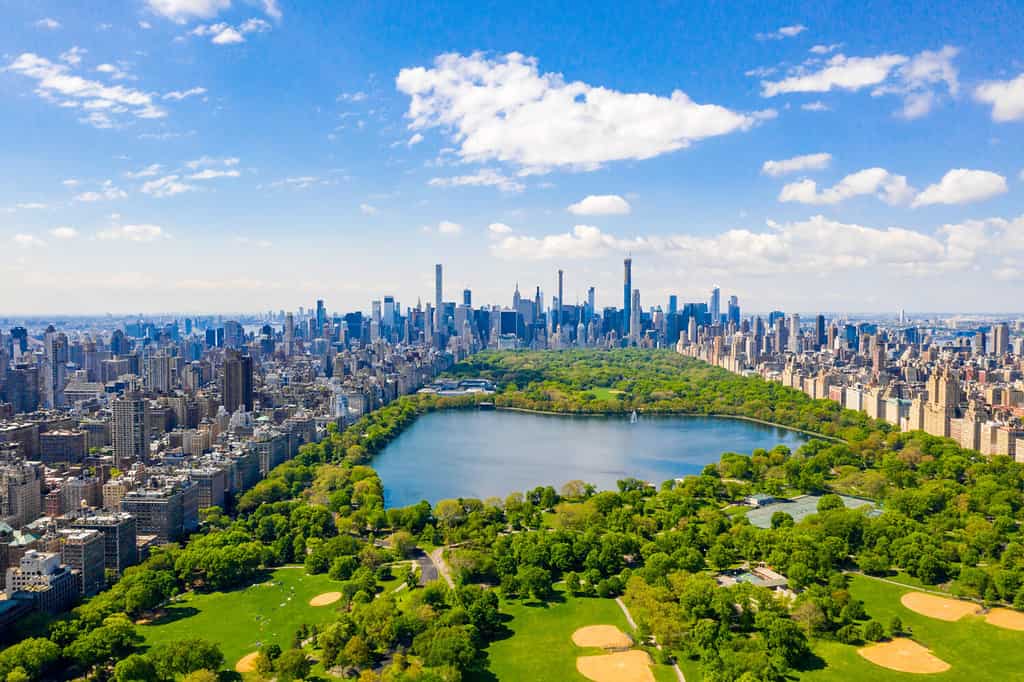
As of 2023, the largest city in the United States, New York, has a population of 7,888,121.
©RAW-films/Shutterstock.com
2. Los Angeles, California
The City of Angels has a population of 3,769,485, making it the second-largest city by population in the United States. However, there’s a bit more space to breathe in Los Angeles, with a population density of 8,038 people per square mile. But it seems like residents are moving onto greener pastures because the population of Los Angeles has also declined since 2020 when 3,889,834 people were living in LA.

The City of Angels has a population of 3,769,485, making it the second-largest city by population in the United States.
©Chones/Shutterstock.com
3. Chicago, Illinois
The Windy City has a population of 2,608,425 people. Chicago’s population has decreased since the 2020 census when the recorded population was 2,741,730 residents. The city spans over 234 miles, with a population density of 11,472 people per square mile.
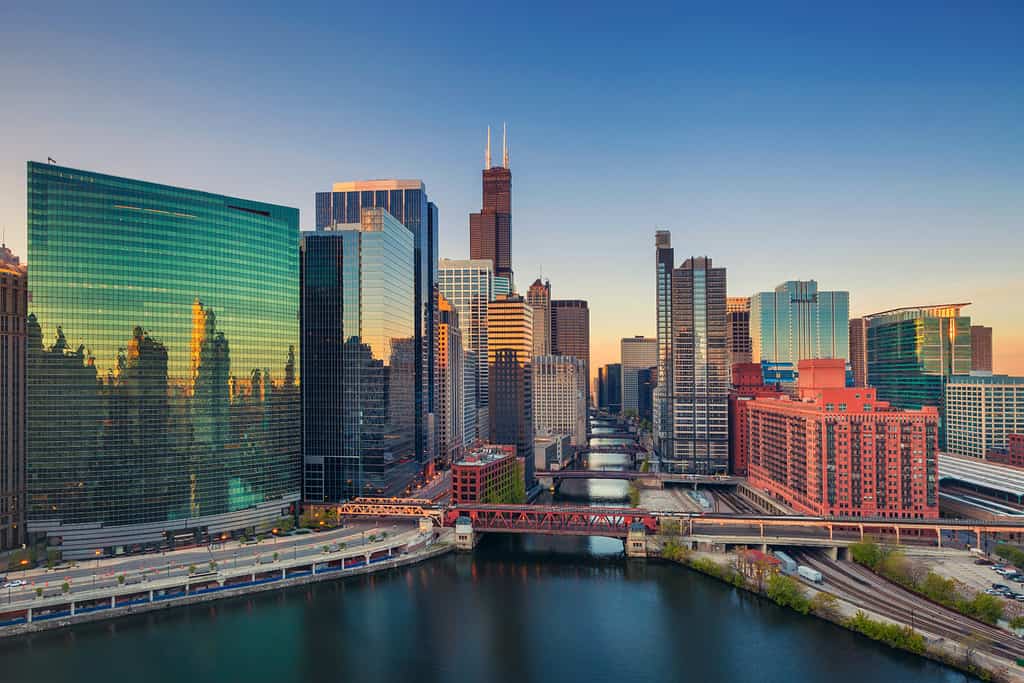
The Windy City has a population of 2,608,425 people.
©Rudy Balasko/Shutterstock.com
4. Houston, Texas
As of 2023, Houston, Texas, has a population of 2,264,876. While Houston hasn’t seen as much of a decline in population compared to New York, it has decreased since 2020, when there were 2,300,027 residents. This Texas city spans over 672 miles, with a population density of 3,538 people per square mile.
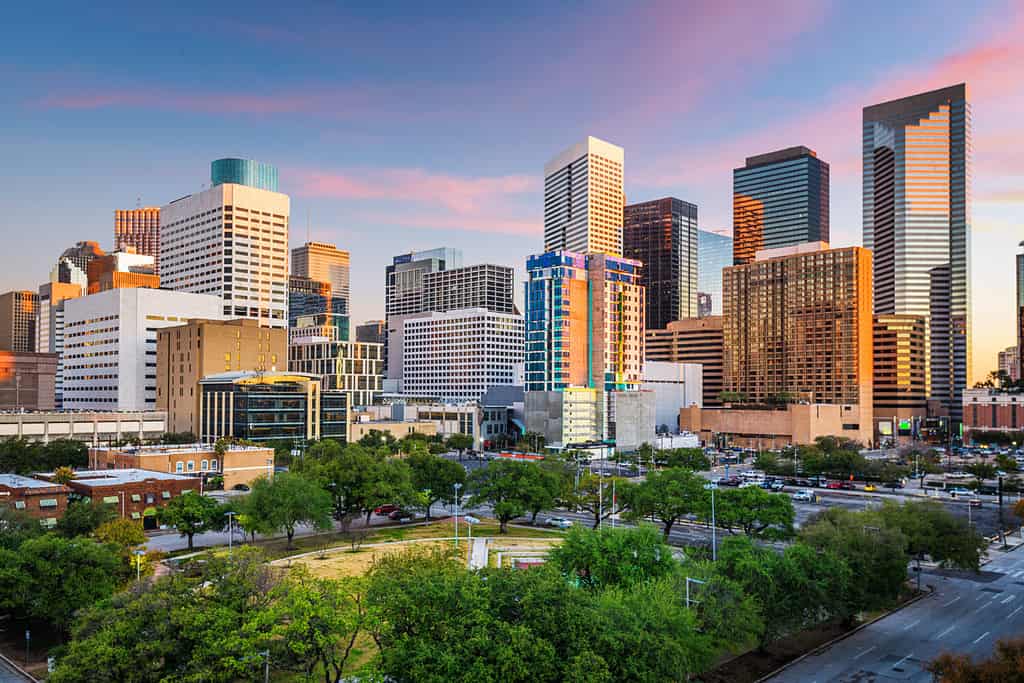
As of 2023, Houston, Texas, has a population of 2,264,876.
©Sean Pavone/Shutterstock.com
5. Phoenix, Arizona
The city of Phoenix, Arizona, has a population of 1,651,344. Phoenix is the first city on this list that is growing, as its population was 1,611,345 in 2020. Since this city spans over 529 miles, it has a population density of 3,190 people per square mile.
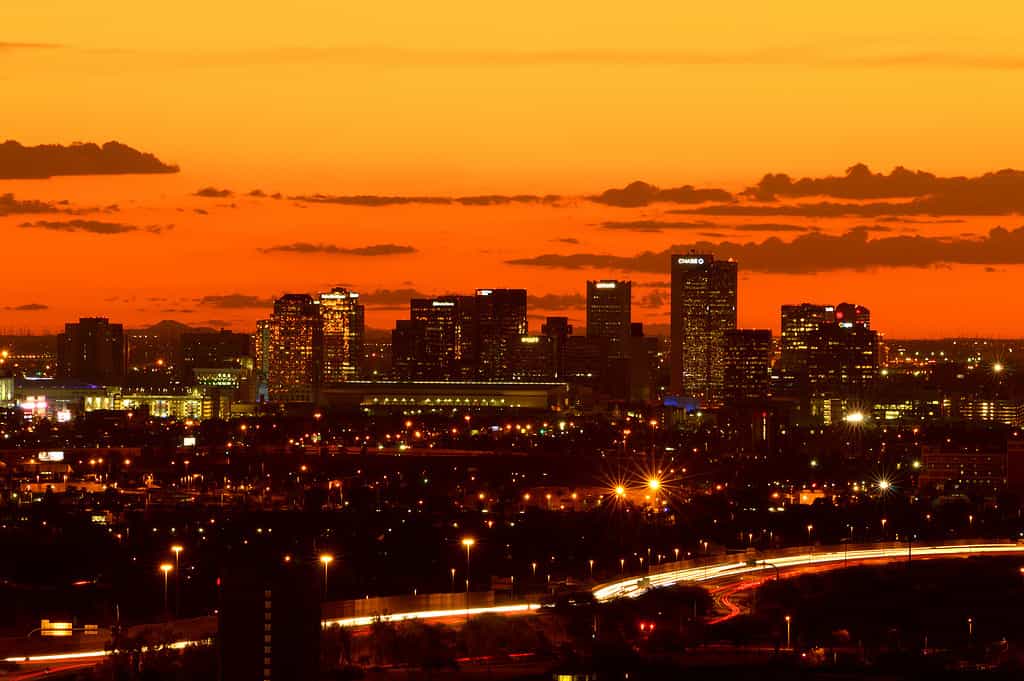
The city of Phoenix, Arizona, has a population of 1,651,344.
©iStock.com/gillcouto

| Rating | City | Total Area |
|---|---|---|
| 1. | Sitka, Alaska | 2,870.30 square miles |
| 2. | Juneau, Alaska | 2,701.90 square miles |
| 3. | Wrangell, Alaska | 2,542.50 square miles |
| 4. | Anchorage, Alaska | 1,704.70 square miles |
| 5. | Jacksonville, Florida | 747 square miles |
1. Sitka, Alaska
The city of Sitka, Alaska, is notorious for its abundance of wildlife and temperate rainforests. There are 85 mountains surrounding Sitka, the highest being Peak 5390, which is 5,390 feet tall. Sitka is the largest city in the United States by total area, covering 2,870.3 square miles.
The climate in Sitka is cold and very overcast. Winters are freezing cold, cloudy, and long, while summers are cool and overcast. For example, temperature varies between 33°F to 62°F throughout the year but rarely dips below 22°F or rises above 68°F.
There are several natural attractions in and around this Alaskan city, including:
- Enjoy the breathtaking hike and many scattered waterfalls at Herring Cove Trail.
- Visit Sitka National Historic Park, also known as Totem Park, and take in this park’s history and culture.
- There are multiple marine life tours where you can do some whale watching.
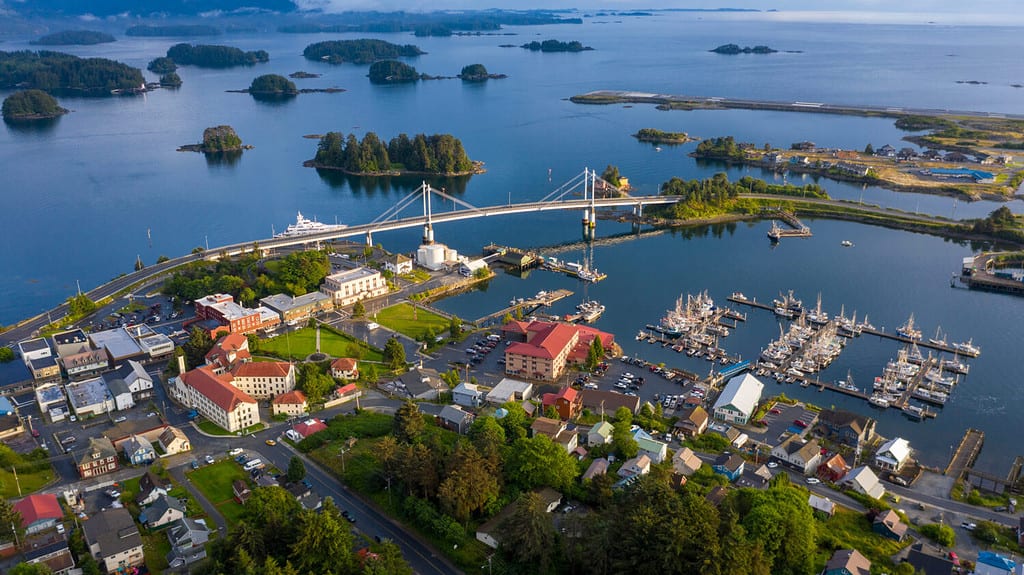
Sitka is the largest city in the United States by total area, covering 2,870.3 square miles.
©Roman Tigal/Shutterstock.com
2. Juneau, Alaska
The city of Juneau, Alaska, is surrounded by glaciers, fjords, and mountains. As a result, it has a relatively mild climate. Summers typically reach highs of low to mid-60s, and winters average 29 degrees. Juneau gets a lot of rain, with 230 days of precipitation throughout the year. While it only has a population of 31,534 residents, it is the second-largest city in the United States by total area, spanning over 2,701.90 square miles. Juneau is a haven for outdoor enthusiasts with several natural attractions, including:
- Glacier Gardens Rainforest
- Mendenhall Glacier
- Whale watching tours
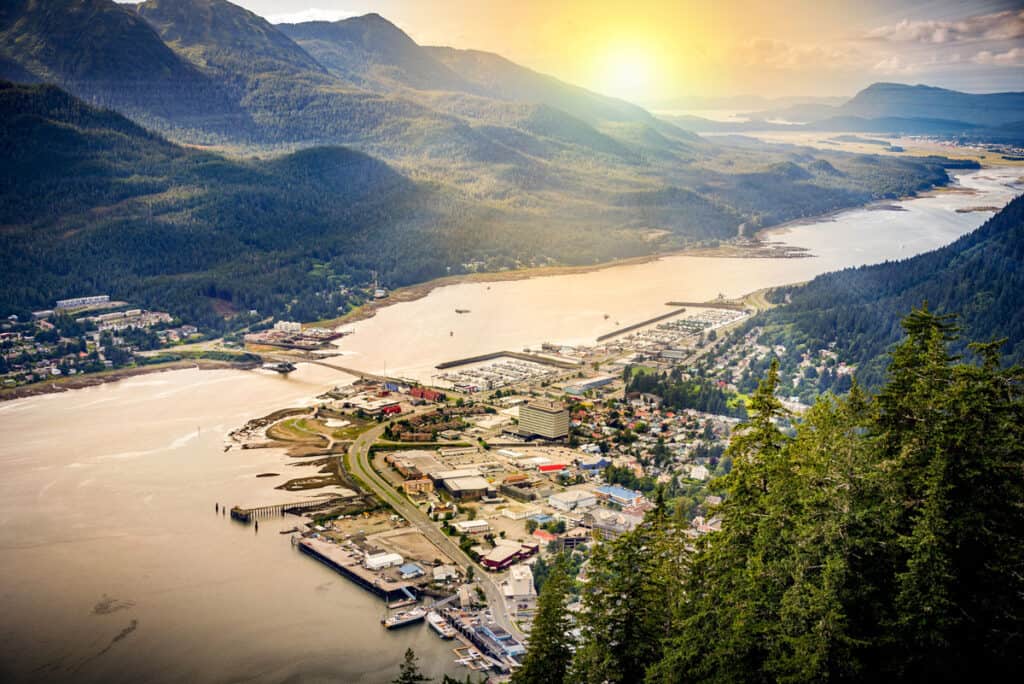
The city of Juneau, Alaska, is surrounded by glaciers, fjords, and mountains.
©iStock.com/chaolik
3. Wrangell, Alaska
Situated on the northwest tip of Wrangell Island, this city spans over 2,542.50 square miles. Wrangell is a picturesque harbor town. Furthermore, it is strategically located near the Stikine River mouth. This Alaskan city is known for its beautiful scenery, wildlife, culture, and for exploring the Stikine River. Wrangell experiences cool summers and long, cold, and wet winters. As a result, the average temperature varies from 29°F to 65°F throughout the year. There are many natural attractions in the area, including:
- Petroglyph Beach State Historic Site
- Mt Dewey Trail
- Bear viewing tours

Wrangell is a picturesque harbor town.
©ClickClick5 / CC BY-SA 4.0 – License
4. Anchorage, Alaska
While Anchorage ranks as the fourth largest city in the United States in total area, it is Alaska’s largest city. Anchorage lies between the Cook Inlet Bay and the Chugach Mountains. It spans over 1,704.70 square miles and has a population of 283,154. This city has cool and cloudy summers and long, freezing winters. As a result, the temperatures range from 13°F to 68°F throughout the year. Tourists can experience several natural attractions while in Anchorage, including:
- Wildlife and Glaciers with a walk in the rainforest
- Eagle River Nature Center
- Byron Glacier trail
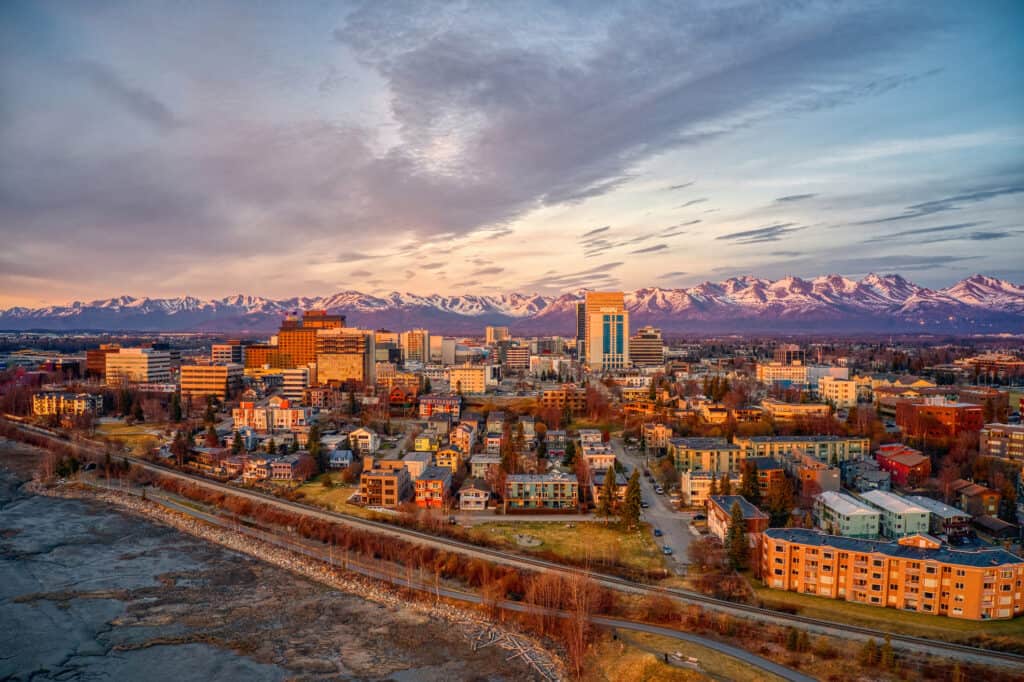
An aerial view of a sunset over downtown Anchorage, Alaska’s largest city with a population of 283,154.
©iStock.com/Jacob Boomsma
5. Jacksonville, Florida
The city of Jacksonville, Florida, is the fifth largest city in the United States by total area, spanning over 747 square miles. Jacksonville is a natural paradise, surrounded by the Atlantic Ocean and nature-filled waterways. This city has a warm climate; summers are long, hot, and cloudy, while winters are cool and short. The average temperature ranges from about 46°F to 90°F throughout the year. Tourists are surrounded by blissful nature, so Jacksonville doesn’t have a big city feeling. Natural attractions in the area include:
- Atlantic Beach
- Castaway Island Preserve
- Timucuan Ecological and Historical Preserve
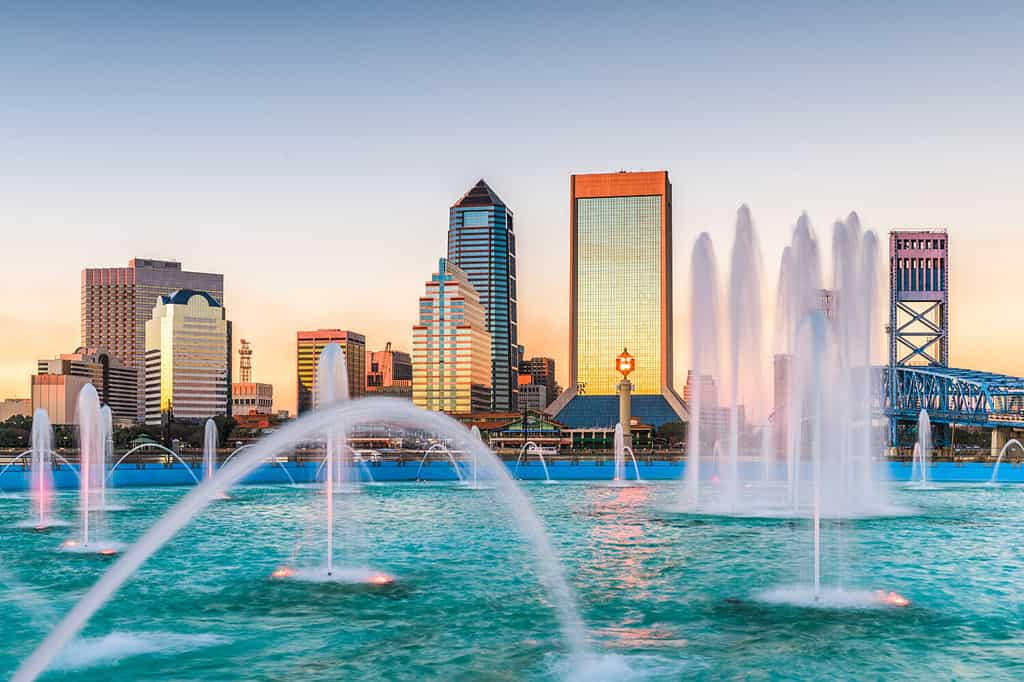
The city of Jacksonville, Florida, is the fifth largest city in the United States by total area.
©Sean Pavone/Shutterstock.com
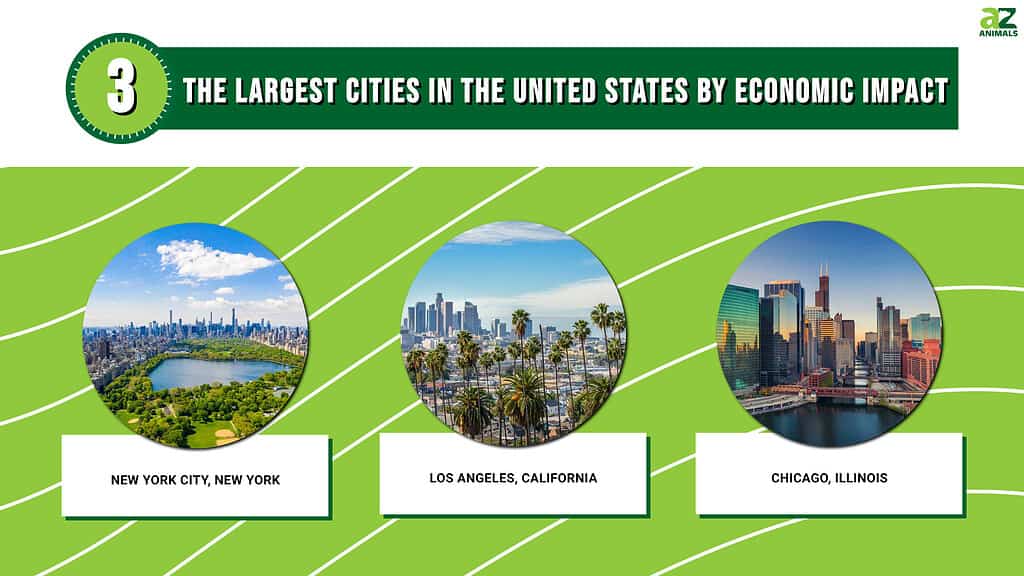
| Ranking | City | GDP |
|---|---|---|
| 1. | New York, New York | $1,992,779,274 |
| 2. | Los Angeles | $1,124,682,354 |
| 3. | Chicago | $764,583,227 |
1. New York
The U.S. city with the most economic impact is New York, with a GDP of $1,992,779,274. The city’s key industries include:
- Finance
- Healthcare
- Professional and business services
- Retail
- Manufacturing
Some of New York’s major employers are JPMorgan Chase & Co, Citigroup Inc, ABM Industries Inc, Pfizer Inc, and Icahn Enterprises LP.
2. Los Angeles
The City of Angels is the second largest city in the United States by economic impact, with a GDP of $1,124,682,354. Los Angeles’s key industries include:
- The entertainment industry
- Aerospace
- Bioscience
- Transportation
- Fashion
Some of the City of Angels’ top employers are Sony Pictures Entrtn Inc, Northrop Grumman, AHMC Healthcare Inc, Space Exploration Tech Corp, and Six Flags Magic Mountain.
3. Chicago
The Windy City has a GDP of $764,583,227, making it the third-largest city in the U.S. by economic impact. Chicago’s key industries include:
- Manufacturing
- Transportation
- IT
- Health and services technology
- Retail
Some of Chicago’s major employers are Amazon, Accenture, IBM, Walgreens, and Boeing.
The photo featured at the top of this post is © IM_photo/Shutterstock.com
Thank you for reading! Have some feedback for us? Contact the AZ Animals editorial team.







